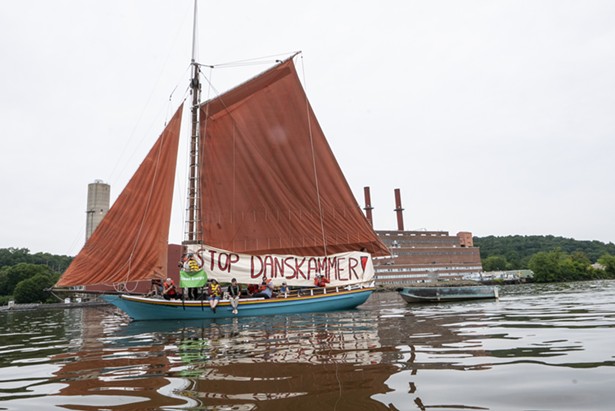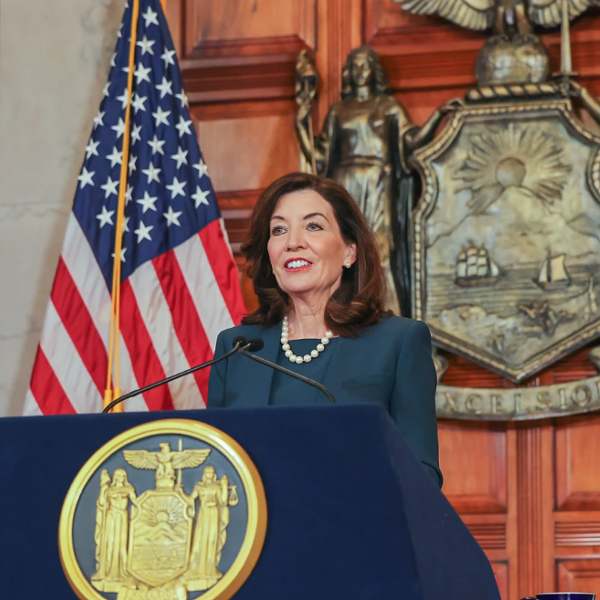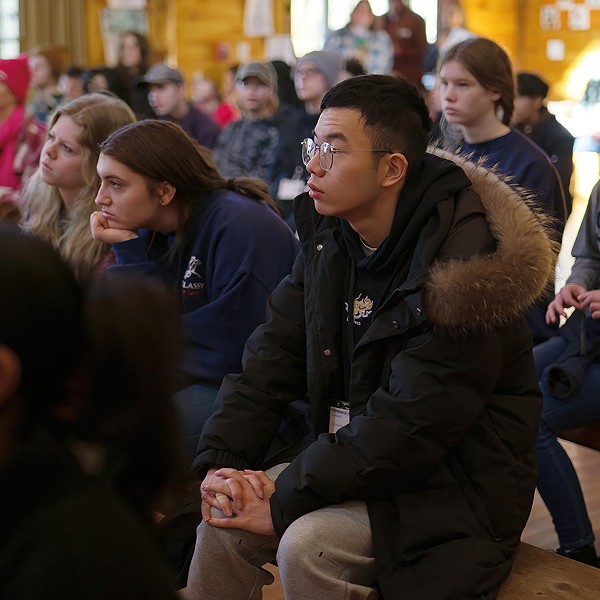Update: On October 27, the New York State Department of Environmental Conversation denied the required permit for an expanded Danskammer power plant on the basis that the project “does not demonstrate compliance with the requirements of the Climate Leadership and Community Protection Act.”
This story was produced in collaboration with HUDSY, a local filmmaking collective that creates and distributes meaningful, high-quality video content from the Hudson Valley. The video was created by Natasha Scully.
Aboard the Woody Guthrie, members of the Beacon Sloop Club—founded by environmental activists Pete and Toshi Seeger in 1969—wait expectantly offshore in front of the Danskammer power plant for a fleet of kayakers to arrive. A few crew members begin to unfold a protest sign. They wonder if it’s too big to hang from the sail.
Slowly, kayakers begin to emerge from over the horizon line. They come in twos and threes; some are as young as 10 and others are longtime residents of Newburgh in their seventies. At first, it seems like only a few have made it across the Hudson, but soon the crowd of kayaks grows to over 50, and a chant rises in volume: “Hey hey, ho ho, Danskammer has got to go!”
It’s Wednesday, August 4, and members of the Stop Danskammer Coalition—a nonpartisan alliance of environmental organizations, community groups, faith-based congregations, and elected officials—have taken to the water to protest a proposal by Danskammer Energy to expand its fracked-gas plant, which is currently under review by the New York State Siting Board. Danskammer is the first major gas-fired power plant to be considered for approval in New York since the 2019 passage of the state’s Climate Leadership and Community Protection Act, which sets out some of the most ambitious clean energy goals in the country.
Among the 60-plus organizations involved in the Stop Danskammer Coalition is the Hudson River Sloop Clearwater, of which the Beacon Sloop Club is a part. The crew members of the Woody Guthrie are here as both sailors and protesters, the water their domain. As the sloop members ready for the oncoming kayakers, they realize the sign is, in fact, too large to hang from the sail. The boat gently rocks back and forth as they lift the canvas above their heads. They’ve concluded that the only viable option is to hold their message up high, and hope it is seen by the protesters and media alike. Only a few hundred feet away, the imposing Danskammer power plant towers above the water, drifting in and out of view as the sky becomes blanketed in canvas, red paint declaring: STOP DANSKAMMER!

A Critical Moment for Climate Progress
The urgent and strikingly to-the-point message of those protesting the expansion of the plant comes at a critical moment. As Danskammer gears up to prove that its expanded plant is necessary for the future of New York—a claim that is becoming more and more difficult to back up amid mounting state-level investment in decarbonization—residents of Newburgh and climate activists watch on.
The existing Danskammer Generating Station is a “peaker” facility, a plant that operates only when there is a high demand for electricity that exceeds the capacity of baseload power plants, which provide the majority of New York’s power. The new proposal calls for replacing the existing plant with a baseload station that would run nearly all the time, a project that seems out of touch with the current needs of the state, and the history of the plant. Danskammer was originally designed as a coal-fired facility in the 1950s, but after the station was significantly damaged by Superstorm Sandy, it was repowered to run on natural gas. Some environmentalists doubt it will survive another flood.
Since then, the plant has been running roughly 10 percent of the year to meet peak power demand. But its potential for greater productivity—and therefore greater profit—was enough to motivate the private equity firm Tiger Infrastructure to join with Agate Power and acquire the plant in 2017. Soon after the acquisition, Danskammer Energy announced that it would seek state approval for a $500 million plan to rebuild the existing plant so that it could once again run full-time.
From the perspective of Danskammer Energy, the switch to a “state-of-the-art” facility is something that needs to happen to ensure the reliability of New York’s electric grid. According to the company’s website, “a modernized Danskammer will help fill the gap” of customers' needs as New York transitions to new facilities. “Danskammer will continue to be used by the State of New York to produce energy,” the site claims, “whether a new facility is built or the old one continues to operate.”
But environmental activists point to a study by the New York Independent System Operator, a nonprofit organization that oversees state electricity needs and coordinates all daily operations, that reported no reliability concerns for the smooth operation of the state’s grid should the Danskammer plant fail to be built.
Danskammer Energy’s claims stretch further than just energy needs, though. From Danskammer’s vantage point, the upgrade will also provide major benefits for the surrounding community. The power plant’s website holds that “the repowering project will support 450+ construction jobs for local workers,” and vaguely maintains that the new plant could eventually be equipped to use hydrogen power “when the technology is available to transport and store hydrogen.”
These claims hold a dual meaning, and monetary stakes, for local officials. In neighboring Marlboro, Danskammer has initiated a payment in lieu of taxes (PILOT) agreement in which the company pays the Marlboro Central School District $1.2 million, a number that will increase to $1.5 million if the proposed expansion plan passes. Separately, in February of 2020, Marlboro approved a four-year community benefit agreement with Danskammer. And as of January 31, Danskammer has agreed to contribute $200,000 annually to the town. Importantly, Danskammer’s current PILOT agreement would be nullified if it applied for a new PILOT for a new plant.
This is not lost on local officials, who are contending with a partnership that has reaped major benefits for the community and school district, largely at the expense of clean air. The Orange County Legislature voted 12-7 in support of the project in 2019. Newburgh Town Supervisor Gil Piaquadio supports Danskammer’s expansion, as does Ulster County legislator Thomas Corcoran, Jr., whose district includes the Marlboro school district. Local unions are also backing the project.
At the state level, too, there has been notable silence on the part of James Skoufis, a Democrat whose district includes Danskammer. Skoufis has not publicly opposed the plant’s expansion, a move that contrasts with several of his colleagues who have openly stated their opposition to the proposal.
These political stances are especially noteworthy given the ambitious climate goals of New York State, which aims to build out an entirely fossil-free electric grid by 2040. In an uncommon move, DEC Commissioner Basil Seggos took to Twitter to say Danskammer’s application materials “haven’t justified the projects or shown compliance with NY’s climate law,” a remark that seemingly reflects the broader sentiment of those tasked with decarbonizing New York’s grid.
“We’ve Been Through This Before”
Tamsin Hollo, a Newburgh resident and member of the Newburgh Clean Water Project, a nonpartisan grassroots group of Newburgh residents advocating for access to clean drinking water and restoration of their watershed, underscores the historical precedence—and compounding effect—of repeated polluting development projects in and around the City of Newburgh, where 25 percent of residents live in poverty.
“Communities like ours are targeted,” Hollo says. “People are too busy surviving to fight. If you talk to a lot of community members, they’ll sort of shrug and say, ‘Of course they’re going to do this.’ We’ve been through this before, so many times.”
The history of environmental abuse in Newburgh stretches back at least a century, to the opening of the DuPont manufacturing facility in 1911, which emitted massive amounts of pollution during its operation. The asthma rate in the City of Newburgh is nearly twice the state average. In 1990, a 4,000-gallon spill of liquid firefighting foam at nearby Stewart Air National Guard Base contaminated the groundwater in the surrounding area with per- and polyfluoroalkyl substances (PFAS), synthetic chemicals that have been linked to chronic kidney disease as well as several forms of cancer. In 2014, Newburgh detected PFAS in Washington Lake, part of its water supply.
If built, the emissions from the new Danskammer plant would include volatile organic compounds and nitrogen oxides, known carcinogens that would most likely further increase the rate of asthma in the area. According to Danskammer’s Article 10 application (the review and approval process for energy plant proposals in New York State), the new plant would also increase its expected annual greenhouse gas emissions from its current rate by nearly 4,000 percent.
Environmental organizers in the Hudson Valley recognized immediately that “this was something that we could not allow to happen in our community,” says Hayley Carlock, director of environmental advocacy and legal affairs for Scenic Hudson and a member of the Stop Danskammer Coalition. Grassroots groups such as Food and Water Watch and Scenic Hudson quickly jumped into action. “It struck us at an early point that we could be a lot more effective if we formalized our partnership and became a coalition,” Carlock says. “That way we could draw from the strengths of all of the different organizations and individuals involved.” Thus, the Stop Danskammer Coalition was born.
The coalition started by meeting virtually once a week, but eventually there were so many people involved that organizers decided to form subcommittees aimed at tackling many different projects at once. Now, there are more than 60 organizations in the coalition. “It’s a good way to kind of just keep that drum beat going and hold us all accountable,'' says Emily Skydel, an organizer with Food and Water Watch.
Skydel explains that each organization fills a different niche. Scenic Hudson often carries the mantle when it comes to lobbying, while Food and Water Watch is able to make use of its ability to tap into grassroots organizing and petition signing. More recently, “big greens” such as the Sierra Club have joined the coalition, and in doing so, brought along their extensive mailing lists.
That said, the coalition works to ensure that all community members can participate, regardless of how much time they have. “Even if someone is super busy or doesn’t want to be on an hourlong call every week, we make sure to create other spaces like roundtables and other events where people can get involved,” Skydel says.
The coalition takes great pride in the diversity of interests and expertise of its members, which organizers also cite as a reason for much of their success. “You’ve got everyone from lawyers to lobbyists to grassroots activists, to folks with a media background or a science background…to a group of five people who meet at someone’s kitchen table,” Carlock says. “I think that it just makes our advocacy so much stronger when we’re speaking from different perspectives.”
Thus far, the Stop Danskammer Coalition has collected the signatures of over 150 elected officials in a letter opposing Danskammer, including a unanimous bipartisan resolution from the Westchester Legislature and municipal resolutions up and down the Hudson River. It has also led pickets outside of the plant, instructed community members through virtual trainings and protests, and organized teach-ins surrounding the significance of the site of Danskammer for Native Americans indigenous to the region.
Vox Populi
The coalition’s greatest efforts, however, have gone toward galvanizing the voices of community members, which has been made more difficult during a pandemic. As Danskammer enters the public comment period of the Article 10 certification process, which is designed to ensure proposals are in agreement with New York State law, the coalition is working to translate what it all means for members of the community, and to ensure that everyone has their voice heard.
Carlock explains that “we’re about halfway through” the Article 10 process. Danskammer has submitted its application and has filed multiple supplements requested by the siting board. The next step in the process is what Carlock calls a “mini-trial” that happens before administrative law judges from both the Department of Environmental Conservation (DEC) and the Department of Legal Services. The siting board is set to make a decision by April of 2022.
At the same time, the proposal is reviewed through a public comment period, which “happens on a parallel track to the legal proceedings,” Carlock says. “I think a lot of times, the public comment period doesn’t get as much attention as it should.”
To complicate things further, Danskammer must acquire a Title V Permit under the Clean Air Act—which is under the DEC’s purview—before the siting board can grant Danskammer an Article 10 certificate. There is currently an open comment period for that permit, with a public hearing slated to take place on August 23 and 25. If Danskammer fails to acquire the Title V Permit, it could be the end of the road for the proposal. The public’s voice is critical at this point, Carlock says.
But the coalition is concerned that community members will not be granted the time and space to share their thoughts on the proposal. At the first public hearing of the siting board at the end of March, between 300 and 400 people showed up to each session over Zoom, with more than 94 percent speaking out against Danskammer.
Because the hearing was planned with fewer attendants in mind, only about half of the people who registered to make a comment were given the opportunity to do so. “If people wait for a few hours to give their comment and then they’re not heard, what are they going to do the next time around? And what does that say about our democracy?” says Jess Mullen, a coordinator with the New Paltz Climate Action Coalition and the coalition’s campaign manager.
Danskammer’s proposal—and the importance of the public’s interest in the project—takes on a new weight following the recent publication of the sixth Intergovernmental Panel on Climate Change report, which UN Secretary General Antonio Cuterres calls a “code red for humanity.”
For those on the frontlines of the climate emergency, the global scale of the problem makes even more crucial the work of local organizing. As Carlock notes, “we’re at a critical inflection point—we have a small window of time to act and if we don’t, the consequences will be disastrous. To permit a new, major gas-burning plant today in light of that makes absolutely no sense and is clearly inconsistent with the state’s climate goals.”
That’s why the Stop Danskammer Coalition is fervent in its calls for community involvement and participation during this public comment period. “There needs to be thousands of people speaking out on this,” Skydel says.
Our Dirty Stream
“Alright,” the captain of the Woody Guthrie announces to those aboard the vessel, “we’re heading back.” As crew members ready the sloop to sail back to Beacon, they discuss plans for the evening: to be back on the water in only a few hours for the river access and sail training the group provides free of charge every weekday evening.
The legacy of Pete Seeger continues aboard the Woody Guthrie, named after the author “This Land is Your Land.” Seeger fought for a future of environmental equity, and hoped for a time in which the Hudson River would be accessible to all. Environmental activists are carrying on that fight for clean water and air.
As members of the Beacon Stoop Club set sail from the shores of the Danskammer power plant, skimming the waves of the Hudson River, the chants of the kayak-clad activists fade into conversation, silence, and laughter.
“Danskammer—that big smokestack on the horizon—can’t keep us from enjoying the Hudson River,” Hollo, of the Newburgh Clean Water Project, says. “The flotilla is a parade that says we are united in finding this important: the preservation of our air, of our water, and of our soil. We will not be daunted or frightened from taking space in front of this archaic monolith.”



















